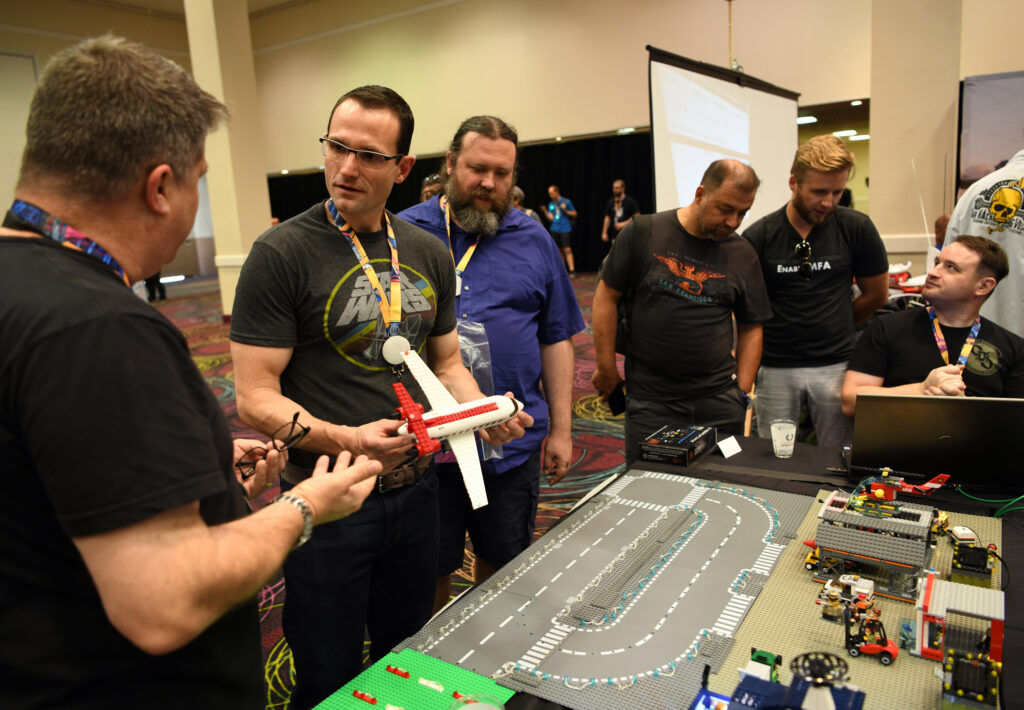
Will Roper, second left, is an avid sci-fi fan.
WASHINGTON: The Advanced Battle Management System (ABMS) has already evolved so far beyond its original aim — to replace the aging E-8 JSTARS plane for surveillance and C2 — that Air Force acquisition czar Will Roper is seriously considering changing the program’s name.
“I think Skynet is out,” he said with a sigh and a grin, “as much as I would love doing that as a sci-fi thing. I just don’t think we can go there. … I do think that we do need to change the name. I don’t think ABMS is primarily a battle management system. It’s an Internet.”
In an very animated Zoom conversation with a small group of reporters yesterday — one that often veered off into sci-fi nerd humor from all sides — Roper explained that his ultimate goal for ABMS is to change the face of warfare. He sees the convergence of the connectivity provided by ABMS serving as a military Internet of Things with artificial intelligence (AI) and machine learning and data fusion as a way to actually avoid war.
“I think what ABMS will grow into will be less of a kill-chain leader. It’ll be more of a machine-to-machine data exchange tool that provides options for deterrence, or for on-ramp or early engagement,” he said. “I think in the future, if we actually have to pull the trigger, it may be viewed as a failure for the system. Because why didn’t this wealth of data give us the ability to avoid getting into that conflict or pulling that trigger all together, given all the ways the US military and the US government has to deter — including our allies and partners? So, I think that’s the direction we’re going, is it to ‘phase zero’ or ‘gray zone’ — that pre- pre-combat phase of conflict.”
(Interestingly, just-retired NORTHCOM commander Gen. Terrence O’Shaughnessy back in May said that one of the key’s to future all-domain warfare will be “predictive analysis” for determining an adversary actions.)
Roper recognizes that this is a long term vision. Indeed, he reiterated, while he was happy to see AI decision-making aides such as Project Maven play a role in yesterday’s ABMS demo, there is a long way to go before it can really fulfill day-to-day operational tasks, much less his long-term vision. (As Breaking D readers know, Roper is moving Project Maven to the Air Force as an analytical tool using the developing ABMS infrastructure.)
Indeed, as I wrote yesterday, he said he isn’t even ready yet to give operators such tools — even though they themselves were pleased with the performance of the tools for generating recommended “courses of action (COAs)” for senior leaders to use in decision-making, even about using forces to defeat targets. While many in the military (and the public) are focused on that “flash-bang” end of the kill chain, Roper explained, focusing AI analytics at the beginning of a crisis would give commanders many more options, including “to engage to the left” prior to actual conflict.
“I’d say our accomplishments today were contributing,” he said cautiously. “They made a difference for the operators, who would take them today if we would let them. But we can do so much more; it is so nascent compared to what AI could really do if we had the right digital architecture fully instantiated. So, I want to see AI play a more fulsome role, and I want to see it go further left. There is no amount of left we should not be focused on.” (In other words, they should be focused on early crisis stages.)
The lack of a modern, 21st century digital architecture of information technology (IT) within DoD has long been one of Roper’s bugaboos: “IT is that novel that Stephen King wrote — IT, it’s a horror,” he said. “That’s a joke, but IT really is a horror film for us. We have not valued it.”
That is slowly changing, he said, because DoD leaders and operators are beginning to realize that “we actually can’t be a warfighting enterprise without world leading, information technology.”
In fact, Roper said, one of the wins for the demo was proving to commanders the capability for C2 from a handheld tablet or phone — using Apple iPads and Samsung Galaxies — with full functionality, including access to secret-level data in a secure way. These “edge” devices, he said, gave commanders “the exact same command and control, the exact same tool set, with the exact same access — all the power that they had in the command center was now in their hands as a tab, and they could do command and control anywhere. We’ve never done that before,” he enthused.
The second ABMS on-ramp yesterday also demonstrated for the first time, use of DoD’s antiquated classified communications network, SIPRnet, for near-real-time C2 decision-making, Northern Command officials told reporters on Tuesday during a briefing at Andrews AFB. The next on-ramp will move further up the classification chain, they said.
Roper said that that while some of the challenges are caused by the “1990s era” computers and software embedded in SIPRnet, much of the problem actually comes down to policies and rules about data-sharing that also are outdated — in large part because they are based on a hyper-conservative view of risk and fear of technology.
“The way the bureaucracies work is to avoid risk at all cost, no matter what the operational impacts. It is to avoid risk today, no matter what the impacts are. We’re going to have to take the big picture view and finally, love IT — not suck at it,” he said.
Further, many of the those policies about information sharing are inconsistent from service to service or government agency to government agency, Roper said.
One of the reasons using SIPRnet is so hard, he explained, “is because we have so many different policies, regulations, in government, and many of those policies don’t convey from organization to organization.”
“And all of those different impediments, all of those different people who have to sign off on something, are a potential ‘no’ in what has to be a chain of ‘yeses’ — all ‘yeses’ — in order to actually operate,” he added. “We need a culture of IT that falls to ‘yes.’
Roper said that moving beyond that risk-averse mindset towards modern IT tech and its capabilities to both share and protect information was discussed among senior military and DoD leadership at the end of the ABMS demo. The roundtable was aimed at planning next steps, he said, and resulted in leaders asking for ideas from the ABMS team about how they could sweep away some of the barriers to implementing the ABMS vision.
“What we talked about as a senior leadership roundtable at the end, is we’re going to have to take risk, prudent risk, in order to become the kind of enterprise that we need to be from a digital perspective, he said. “The time to take risk is now it’s not during conflict.”

Preston Dunlap, Air Force Chief Architect, briefs DoD senior leaders on how the ABMS works during the first ABMS live demonstration at Eglin Air Force Base, Fla., Dec. 18, 2019.
But, back to the new name for ABMS. Roper also rejected the name “ringONE” — based on the ABMS program’s use of the ONE suffix to connote its family of applications — suggested by colleague Valerie Insinna. (The ONE, itself, is a Star Wars reference, Roper noted, as in ‘one with the Force.’)
“RingONE? Is that that’s what you’re suggesting Valerie, like the ‘one ring to rule them all?’ That’s kind of not what we want,” Roper said laughingly. “I’m a huge ‘Lord of the Rings’ fan, but I have been asked that question jokingly in the Pentagon, and we don’t have one system even within ABMS.”
Roper explained that during yesterday’s demo “there were five different AI related tools” used, all in competition with each other, and that this model is being used for all the various ONE applications envisioned under ABMS.
“That’s actually our future. There’s not going to be one thing in every tech stack, no. We love competition, but everything in the tech stack will work together seamlessly,” he explained.
In addition, he said, the “one ring” concept plays into fears already simmering in the other services, especially the Army, as Sydney has reported. The worry is that the Air Force is maneuvering to have ABMS replace the C2 networks they use — giving it control of the entire Joint All-Domain Command and Control (JADC2) network now being fleshed out to run future all-domain, global conflicts against Russia and China.
This could not be further from the truth, Roper said. Instead, he sees ABMS as one part of the future military Internet of Things.
“ABMS will not be the only part of the Internet. There will be IBCS for the Army and CEC for the Navy, and anything that’s generating data and moving it. There’s no need to change it or redo it. We simply need to know how to speak those languages. How do I speak IBCS? How do I speak CEC? How do I speak Aegis? … And if we get it right, all these systems really will converge into one militarized Internet of Things.”
IBCS is an awkward nested acronym for Integrated Air & Missile Defense (IAMD) Battle Command System. The network is intended to share data and commands seamlessly among a wide range of historically incompatible systems across the Army and, potentially, the other services.
CEC is the Navy’s Cooperative Engagement Capability, a command and control network to share targeting data among Navy ships, its Aegis missile defense system, and aircraft such as the E-2 Hawkeye. The Navy also uses a newer system, called Naval Integrated Fire Control – Counter-Air (NIFC-CA) network.
Indeed, Roper said in musing upon a new name for ABMS, “I’ve always loved the Army’s term ‘convergence.’ I think it’s the right idea that the Army is teeing up. That’s why we use the name ‘ONE’ at the end of a tech stack, because we want our tech stack, and all the systems connected with it, to work as one system of systems. … They should all converge to work like one integrated system.”
And while not appropriate for ABMS, Roper mused that perhaps the name ‘ringONE’ could be used in future for the ABMS tech stack, although he jokingly wondered about the implications. “Would that make me the Dark Lord, for forging the One Ring?” he asked. “I don’t know if I can go there.”
But even though Roper himself has yet to decide on what ABMS should be called in the future, he said he “would not be surprised if our chief, and secretary, eventually decide to do a name change.”
Join the quest and send your suggestions for a new name to us!
Norway’s top officer on his ‘biggest challenge,’ next frigate and new NATO neighbors
Gen. Eirik Kristoffersen, Norway’s Chief of Defense, talks to Breaking Defense about his plans for spending on new frigates and subs, the challenges of upgrading Norway’s “digital backbone” and refilling the military’s stocks.



























